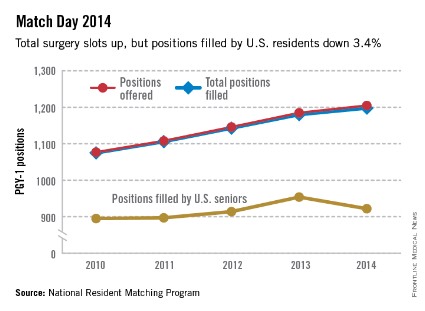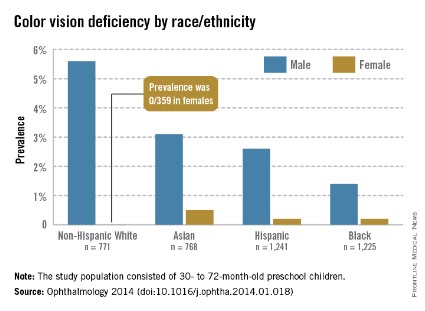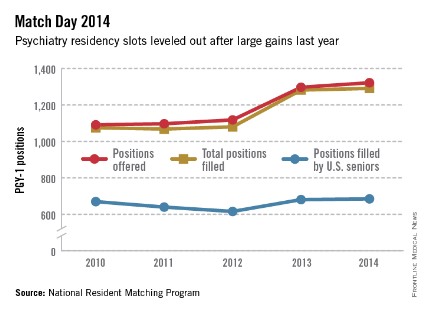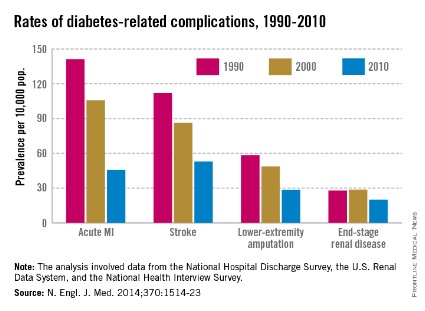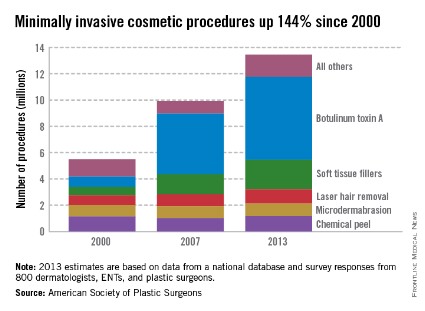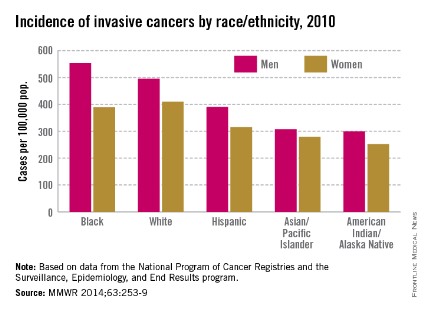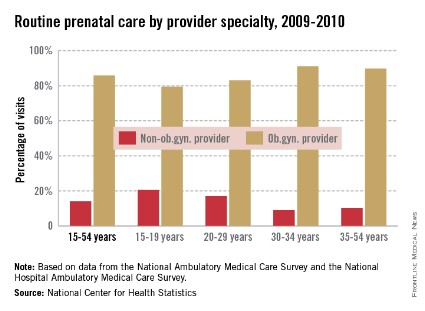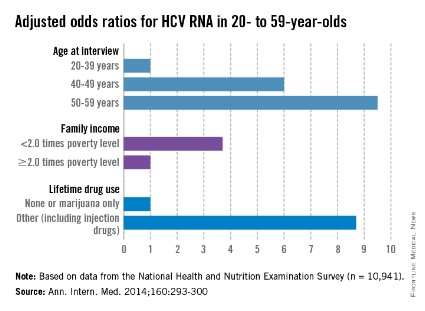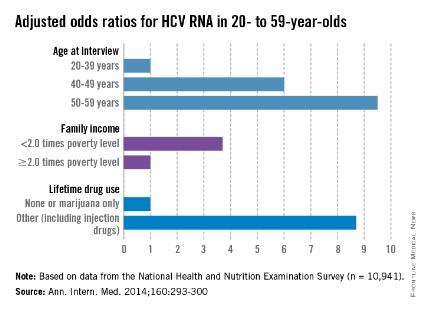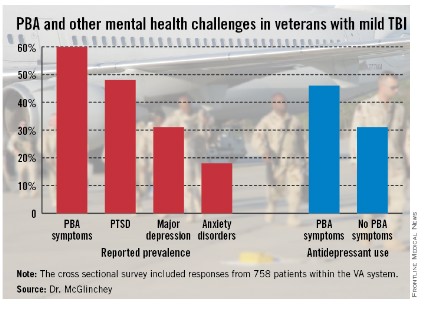User login
Richard Franki is the associate editor who writes and creates graphs. He started with the company in 1987, when it was known as the International Medical News Group. In his years as a journalist, Richard has worked for Cap Cities/ABC, Disney, Harcourt, Elsevier, Quadrant, Frontline, and Internet Brands. In the 1990s, he was a contributor to the ill-fated Indications column, predecessor of Livin' on the MDedge.
U.S. residents fill fewer surgery slots in 2014 Match
The number of surgery residency positions available in this year’s Match was up 2.1% over last year, but the number of U.S. seniors filling surgery slots dropped 3.4%, the National Residency Matching Program reported.
A total of 1,205 surgery slots were offered for 2014, compared with 1,180 in 2013. Of the available slots, 99.4% (1,198) were filled, with 76.5% (922) going to U.S. seniors. The number of U.S. seniors was 954 last year, for a fill rate of 80.8%, according to the NRMP.
The 1,205 surgery positions represent 4.5% of the total slots offered for all specialties. The 29,671 first- and second-year residency positions offered in 2014 was a Match Day record – 500 more than the previous high set in 2013.
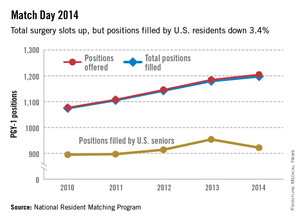
The number of surgery residency positions available in this year’s Match was up 2.1% over last year, but the number of U.S. seniors filling surgery slots dropped 3.4%, the National Residency Matching Program reported.
A total of 1,205 surgery slots were offered for 2014, compared with 1,180 in 2013. Of the available slots, 99.4% (1,198) were filled, with 76.5% (922) going to U.S. seniors. The number of U.S. seniors was 954 last year, for a fill rate of 80.8%, according to the NRMP.
The 1,205 surgery positions represent 4.5% of the total slots offered for all specialties. The 29,671 first- and second-year residency positions offered in 2014 was a Match Day record – 500 more than the previous high set in 2013.

The number of surgery residency positions available in this year’s Match was up 2.1% over last year, but the number of U.S. seniors filling surgery slots dropped 3.4%, the National Residency Matching Program reported.
A total of 1,205 surgery slots were offered for 2014, compared with 1,180 in 2013. Of the available slots, 99.4% (1,198) were filled, with 76.5% (922) going to U.S. seniors. The number of U.S. seniors was 954 last year, for a fill rate of 80.8%, according to the NRMP.
The 1,205 surgery positions represent 4.5% of the total slots offered for all specialties. The 29,671 first- and second-year residency positions offered in 2014 was a Match Day record – 500 more than the previous high set in 2013.

Color blindness most prevalent in white children
Color vision deficiency was significantly more prevalent among non-Hispanic white boys than among blacks and Hispanics in a study involving more than 4,000 preschool-age children.
Prevalence among non-Hispanic white boys aged 30-72 months was 5.6%, compared with 1.4% in black boys and 2.6% in Hispanics boys. Prevalence in Asian boys was lower at 3.1%, but the difference was not significant, Dr. John Z. Xie and his associates reported (Ophthalmology 2014 [doi:10.1016/j.ophtha.2014.01.018]).
Of the 4,005 children tested, 63 were found to have color vision deficiency: 59 were boys and 4 were girls, and none of the 4 girls was white, said Dr. Xie of the Gavin Herbert Eye Institute at the University of California, Irvine, and his associates.
All of the subjects were participants in the Multi-Ethnic Pediatric Eye Diseases Study, a population-based, cross-sectional study of preschool children in Southern California. The study was supported by the National Institutes of Health and an unrestricted grant from Research to Prevent Blindness.
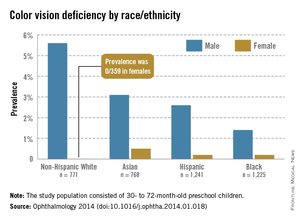
Color vision deficiency was significantly more prevalent among non-Hispanic white boys than among blacks and Hispanics in a study involving more than 4,000 preschool-age children.
Prevalence among non-Hispanic white boys aged 30-72 months was 5.6%, compared with 1.4% in black boys and 2.6% in Hispanics boys. Prevalence in Asian boys was lower at 3.1%, but the difference was not significant, Dr. John Z. Xie and his associates reported (Ophthalmology 2014 [doi:10.1016/j.ophtha.2014.01.018]).
Of the 4,005 children tested, 63 were found to have color vision deficiency: 59 were boys and 4 were girls, and none of the 4 girls was white, said Dr. Xie of the Gavin Herbert Eye Institute at the University of California, Irvine, and his associates.
All of the subjects were participants in the Multi-Ethnic Pediatric Eye Diseases Study, a population-based, cross-sectional study of preschool children in Southern California. The study was supported by the National Institutes of Health and an unrestricted grant from Research to Prevent Blindness.

Color vision deficiency was significantly more prevalent among non-Hispanic white boys than among blacks and Hispanics in a study involving more than 4,000 preschool-age children.
Prevalence among non-Hispanic white boys aged 30-72 months was 5.6%, compared with 1.4% in black boys and 2.6% in Hispanics boys. Prevalence in Asian boys was lower at 3.1%, but the difference was not significant, Dr. John Z. Xie and his associates reported (Ophthalmology 2014 [doi:10.1016/j.ophtha.2014.01.018]).
Of the 4,005 children tested, 63 were found to have color vision deficiency: 59 were boys and 4 were girls, and none of the 4 girls was white, said Dr. Xie of the Gavin Herbert Eye Institute at the University of California, Irvine, and his associates.
All of the subjects were participants in the Multi-Ethnic Pediatric Eye Diseases Study, a population-based, cross-sectional study of preschool children in Southern California. The study was supported by the National Institutes of Health and an unrestricted grant from Research to Prevent Blindness.

FROM OPHTHALMOLOGY
Match Day 2014: Psychiatry positions up slightly
The number of psychiatry residency positions available in this year’s Match was up 1.9% more than last year, the National Residency Matching Program reported.
A total of 1,322 psychiatry slots were offered for 2014, compared with 1,297 in 2013. Of the available slots, 97.7% (1,291) were filled, with 51.8% (685) going to U.S. seniors, according to the NRMP.
The 1,322 psychiatry positions represent 5% of the total slots offered for all specialties. The 29,671 first- and second-year residency positions offered in 2014 was a Match Day record – 500 more than the previous high set in 2013.
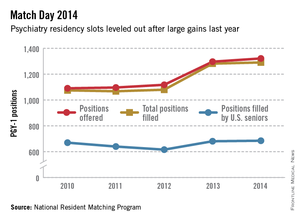
The number of psychiatry residency positions available in this year’s Match was up 1.9% more than last year, the National Residency Matching Program reported.
A total of 1,322 psychiatry slots were offered for 2014, compared with 1,297 in 2013. Of the available slots, 97.7% (1,291) were filled, with 51.8% (685) going to U.S. seniors, according to the NRMP.
The 1,322 psychiatry positions represent 5% of the total slots offered for all specialties. The 29,671 first- and second-year residency positions offered in 2014 was a Match Day record – 500 more than the previous high set in 2013.

The number of psychiatry residency positions available in this year’s Match was up 1.9% more than last year, the National Residency Matching Program reported.
A total of 1,322 psychiatry slots were offered for 2014, compared with 1,297 in 2013. Of the available slots, 97.7% (1,291) were filled, with 51.8% (685) going to U.S. seniors, according to the NRMP.
The 1,322 psychiatry positions represent 5% of the total slots offered for all specialties. The 29,671 first- and second-year residency positions offered in 2014 was a Match Day record – 500 more than the previous high set in 2013.

Complication rates decline among diabetes patients
The rate of diabetes-related myocardial infarction has fallen almost 68% since 1990, according to an analysis of several federal data sources.
From 1990 to 2010, the rate of acute MI among adults with diabetes fell from 141 cases/10,000 diabetes patients to 45.5/10,000, Edward W. Gregg, Ph.D. and associates reported.
The rate of diabetes-related stroke was down 53% from 1990 to 2010, dropping from 112 cases/10,000 patients to 53/10,000. Lower-extremity amputations declined by 51% over the same period, as the rate went from 58 cases/10,000 to 28/10,000. The rate of end-stage renal disease fell from 28 cases/10,000 in 1990 to 20/10,000 in 2010 for a 28% decline.
These decreases among diabetes patients surpassed the reductions seen among the nondiabetic population over the same time period, but "the large increase in the number of prevalent cases of diabetes" suggests that "the total burden, or absolute number of cases of complications, will probably continue to increase in the coming decades," wrote Dr. Gregg of the Centers for Disease Control and Prevention, Atlanta, and his associates (N. Engl. J. Med. 2014;370:1514-23).
The analysis involved data from the National Hospital Discharge Survey, the U.S. Renal Data System, and the National Health Interview Survey.
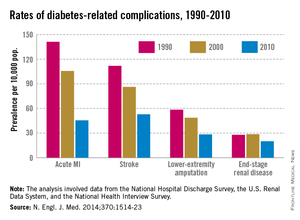
The rate of diabetes-related myocardial infarction has fallen almost 68% since 1990, according to an analysis of several federal data sources.
From 1990 to 2010, the rate of acute MI among adults with diabetes fell from 141 cases/10,000 diabetes patients to 45.5/10,000, Edward W. Gregg, Ph.D. and associates reported.
The rate of diabetes-related stroke was down 53% from 1990 to 2010, dropping from 112 cases/10,000 patients to 53/10,000. Lower-extremity amputations declined by 51% over the same period, as the rate went from 58 cases/10,000 to 28/10,000. The rate of end-stage renal disease fell from 28 cases/10,000 in 1990 to 20/10,000 in 2010 for a 28% decline.
These decreases among diabetes patients surpassed the reductions seen among the nondiabetic population over the same time period, but "the large increase in the number of prevalent cases of diabetes" suggests that "the total burden, or absolute number of cases of complications, will probably continue to increase in the coming decades," wrote Dr. Gregg of the Centers for Disease Control and Prevention, Atlanta, and his associates (N. Engl. J. Med. 2014;370:1514-23).
The analysis involved data from the National Hospital Discharge Survey, the U.S. Renal Data System, and the National Health Interview Survey.

The rate of diabetes-related myocardial infarction has fallen almost 68% since 1990, according to an analysis of several federal data sources.
From 1990 to 2010, the rate of acute MI among adults with diabetes fell from 141 cases/10,000 diabetes patients to 45.5/10,000, Edward W. Gregg, Ph.D. and associates reported.
The rate of diabetes-related stroke was down 53% from 1990 to 2010, dropping from 112 cases/10,000 patients to 53/10,000. Lower-extremity amputations declined by 51% over the same period, as the rate went from 58 cases/10,000 to 28/10,000. The rate of end-stage renal disease fell from 28 cases/10,000 in 1990 to 20/10,000 in 2010 for a 28% decline.
These decreases among diabetes patients surpassed the reductions seen among the nondiabetic population over the same time period, but "the large increase in the number of prevalent cases of diabetes" suggests that "the total burden, or absolute number of cases of complications, will probably continue to increase in the coming decades," wrote Dr. Gregg of the Centers for Disease Control and Prevention, Atlanta, and his associates (N. Engl. J. Med. 2014;370:1514-23).
The analysis involved data from the National Hospital Discharge Survey, the U.S. Renal Data System, and the National Health Interview Survey.

FROM THE NEW ENGLAND JOURNAL OF MEDICINE
Botulinum toxin A tops list of nonsurgical cosmetic procedures in 2013
Injection of botulinum toxin type A continues to be the most popular form of minimally invasive cosmetic surgery, with a total of more than 6.3 million procedures performed in 2013, the American Society of Plastic Surgeons reported.
Overall, botulinum toxins such as Botox and Dysport accounted for 47% of the market for minimally invasive procedures, which totaled 13.4 million procedures in 2013, according to the ASPS.
The second most popular surgery was injection of soft tissue fillers, with 2.2 million procedures performed, followed by chemical peels (1.2 million procedures), laser hair removal (1.1 million), and microdermabrasion (970,000), the ASPS said.
The total number of minimally invasive procedures increased by 3% from 2012, as did the number of botulinum injections. The largest increase for a single type of procedure was seen for the soft tissue fillers, with hyaluronic acid injections up 18% from 2012 to 2013, the ASPS noted.
The estimates for 2013 are based on data from a national database and survey responses from 800 dermatologists, ENTs, and plastic surgeons.
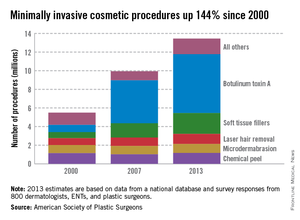
Injection of botulinum toxin type A continues to be the most popular form of minimally invasive cosmetic surgery, with a total of more than 6.3 million procedures performed in 2013, the American Society of Plastic Surgeons reported.
Overall, botulinum toxins such as Botox and Dysport accounted for 47% of the market for minimally invasive procedures, which totaled 13.4 million procedures in 2013, according to the ASPS.
The second most popular surgery was injection of soft tissue fillers, with 2.2 million procedures performed, followed by chemical peels (1.2 million procedures), laser hair removal (1.1 million), and microdermabrasion (970,000), the ASPS said.
The total number of minimally invasive procedures increased by 3% from 2012, as did the number of botulinum injections. The largest increase for a single type of procedure was seen for the soft tissue fillers, with hyaluronic acid injections up 18% from 2012 to 2013, the ASPS noted.
The estimates for 2013 are based on data from a national database and survey responses from 800 dermatologists, ENTs, and plastic surgeons.

Injection of botulinum toxin type A continues to be the most popular form of minimally invasive cosmetic surgery, with a total of more than 6.3 million procedures performed in 2013, the American Society of Plastic Surgeons reported.
Overall, botulinum toxins such as Botox and Dysport accounted for 47% of the market for minimally invasive procedures, which totaled 13.4 million procedures in 2013, according to the ASPS.
The second most popular surgery was injection of soft tissue fillers, with 2.2 million procedures performed, followed by chemical peels (1.2 million procedures), laser hair removal (1.1 million), and microdermabrasion (970,000), the ASPS said.
The total number of minimally invasive procedures increased by 3% from 2012, as did the number of botulinum injections. The largest increase for a single type of procedure was seen for the soft tissue fillers, with hyaluronic acid injections up 18% from 2012 to 2013, the ASPS noted.
The estimates for 2013 are based on data from a national database and survey responses from 800 dermatologists, ENTs, and plastic surgeons.

Invasive cancer incidence highest in black men
Men had a 24% higher incidence of invasive cancer than women in 2010, and black men had the highest rate among men of all races/ethnicities, the Centers for Disease Control and Prevention reported March 27.
Among women, however, the incidence of invasive cancers was highest among whites – 410 cases per 100,000 population – in 2010, the last year for which data are available. Black women had the second-highest rate: 389 per 100,000. In comparison, black men had an incidence of 553 per 100,000 and white men had a rate of 495 per 100,000, the CDC said (MMWR 2014:63;253-9).
The overall incidence rates were 503 per 100,000 for all men and 405 for all women. The total U.S. rate was 446 per 100,000 in 2010, compared with 459 in 2009, according to the CDC, which defined invasive cancers as "all cancers except in situ cancers (other than in the urinary bladder) and basal and squamous cell skin cancers."

Men had a 24% higher incidence of invasive cancer than women in 2010, and black men had the highest rate among men of all races/ethnicities, the Centers for Disease Control and Prevention reported March 27.
Among women, however, the incidence of invasive cancers was highest among whites – 410 cases per 100,000 population – in 2010, the last year for which data are available. Black women had the second-highest rate: 389 per 100,000. In comparison, black men had an incidence of 553 per 100,000 and white men had a rate of 495 per 100,000, the CDC said (MMWR 2014:63;253-9).
The overall incidence rates were 503 per 100,000 for all men and 405 for all women. The total U.S. rate was 446 per 100,000 in 2010, compared with 459 in 2009, according to the CDC, which defined invasive cancers as "all cancers except in situ cancers (other than in the urinary bladder) and basal and squamous cell skin cancers."

Men had a 24% higher incidence of invasive cancer than women in 2010, and black men had the highest rate among men of all races/ethnicities, the Centers for Disease Control and Prevention reported March 27.
Among women, however, the incidence of invasive cancers was highest among whites – 410 cases per 100,000 population – in 2010, the last year for which data are available. Black women had the second-highest rate: 389 per 100,000. In comparison, black men had an incidence of 553 per 100,000 and white men had a rate of 495 per 100,000, the CDC said (MMWR 2014:63;253-9).
The overall incidence rates were 503 per 100,000 for all men and 405 for all women. The total U.S. rate was 446 per 100,000 in 2010, compared with 459 in 2009, according to the CDC, which defined invasive cancers as "all cancers except in situ cancers (other than in the urinary bladder) and basal and squamous cell skin cancers."

FROM MORBIDITY AND MORTALITY WEEKLY REPORT
Prenatal visits to non-ob.gyn. providers more common in younger women
Women aged 15-29 years are more likely than older women to see a non-ob.gyn. for their routine prenatal care, the National Center for Health Statistics reported.
In 2009-2010, women aged 15-19 years saw a non-ob.gyn. provider for 20.5% of their routine prenatal care visits, and women aged 20-29 years went to a non-ob.gyn. provider for 17% of such visits. In comparison, only 8.9% of visits by women aged 30-34 years and 10.3% of visits by women 35-54 involved a non-ob.gyn. provider, the NCHS said.
Overall, women aged 15-54 years saw a non-ob.gyn. provider for 14.1% of their routine prenatal care visits, according to data from the National Ambulatory Medical Care Survey and the National Hospital Ambulatory Medical Care Survey.
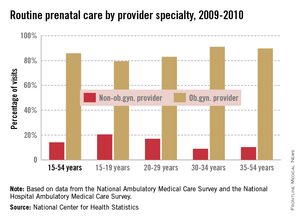
Women aged 15-29 years are more likely than older women to see a non-ob.gyn. for their routine prenatal care, the National Center for Health Statistics reported.
In 2009-2010, women aged 15-19 years saw a non-ob.gyn. provider for 20.5% of their routine prenatal care visits, and women aged 20-29 years went to a non-ob.gyn. provider for 17% of such visits. In comparison, only 8.9% of visits by women aged 30-34 years and 10.3% of visits by women 35-54 involved a non-ob.gyn. provider, the NCHS said.
Overall, women aged 15-54 years saw a non-ob.gyn. provider for 14.1% of their routine prenatal care visits, according to data from the National Ambulatory Medical Care Survey and the National Hospital Ambulatory Medical Care Survey.

Women aged 15-29 years are more likely than older women to see a non-ob.gyn. for their routine prenatal care, the National Center for Health Statistics reported.
In 2009-2010, women aged 15-19 years saw a non-ob.gyn. provider for 20.5% of their routine prenatal care visits, and women aged 20-29 years went to a non-ob.gyn. provider for 17% of such visits. In comparison, only 8.9% of visits by women aged 30-34 years and 10.3% of visits by women 35-54 involved a non-ob.gyn. provider, the NCHS said.
Overall, women aged 15-54 years saw a non-ob.gyn. provider for 14.1% of their routine prenatal care visits, according to data from the National Ambulatory Medical Care Survey and the National Hospital Ambulatory Medical Care Survey.

Risk Factors Quantified for Hepatitis C
The risk factors most associated with chronic hepatitis C virus infection in Americans aged 20-59 years are age 40-59 years, illicit drug use other than marijuana, and family income less than twice the poverty level, according to investigators from the Centers for Disease Control and Prevention.
Data from 10,941 participants in the National Health and Nutrition Examination Survey (2003-2010) show that those aged 50-59 years were 9.5 times more likely and those aged 40-49 were 6.0 times more likely to have HCV infection than 20- to 39-years-olds, reported Dr. Maxine M. Denniston and her associates (Ann. Intern. Med. 2014;160:293-300).
Survey respondents who reported lifetime drug use other than marijuana (including injection drugs) were 8.7 times more likely to have chronic HCV than those with no drug use or marijuana use only, and those with a family income less than twice the poverty level were 3.7 times more likely to have HCV than were those with incomes more than twice the poverty level, the investigators reported.
Other statistically significant risk factors include male sex (odds ratio, 1.6), non-Hispanic black race/ethnicity (OR, 1.6), and high school education or less (OR, 2.0), they said.
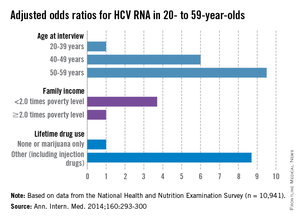
The risk factors most associated with chronic hepatitis C virus infection in Americans aged 20-59 years are age 40-59 years, illicit drug use other than marijuana, and family income less than twice the poverty level, according to investigators from the Centers for Disease Control and Prevention.
Data from 10,941 participants in the National Health and Nutrition Examination Survey (2003-2010) show that those aged 50-59 years were 9.5 times more likely and those aged 40-49 were 6.0 times more likely to have HCV infection than 20- to 39-years-olds, reported Dr. Maxine M. Denniston and her associates (Ann. Intern. Med. 2014;160:293-300).
Survey respondents who reported lifetime drug use other than marijuana (including injection drugs) were 8.7 times more likely to have chronic HCV than those with no drug use or marijuana use only, and those with a family income less than twice the poverty level were 3.7 times more likely to have HCV than were those with incomes more than twice the poverty level, the investigators reported.
Other statistically significant risk factors include male sex (odds ratio, 1.6), non-Hispanic black race/ethnicity (OR, 1.6), and high school education or less (OR, 2.0), they said.

The risk factors most associated with chronic hepatitis C virus infection in Americans aged 20-59 years are age 40-59 years, illicit drug use other than marijuana, and family income less than twice the poverty level, according to investigators from the Centers for Disease Control and Prevention.
Data from 10,941 participants in the National Health and Nutrition Examination Survey (2003-2010) show that those aged 50-59 years were 9.5 times more likely and those aged 40-49 were 6.0 times more likely to have HCV infection than 20- to 39-years-olds, reported Dr. Maxine M. Denniston and her associates (Ann. Intern. Med. 2014;160:293-300).
Survey respondents who reported lifetime drug use other than marijuana (including injection drugs) were 8.7 times more likely to have chronic HCV than those with no drug use or marijuana use only, and those with a family income less than twice the poverty level were 3.7 times more likely to have HCV than were those with incomes more than twice the poverty level, the investigators reported.
Other statistically significant risk factors include male sex (odds ratio, 1.6), non-Hispanic black race/ethnicity (OR, 1.6), and high school education or less (OR, 2.0), they said.

FROM ANNALS OF INTERNAL MEDICINE
Risk factors quantified for hepatitis C
The risk factors most associated with chronic hepatitis C virus infection in Americans aged 20-59 years are age 40-59 years, illicit drug use other than marijuana, and family income less than twice the poverty level, according to investigators from the Centers for Disease Control and Prevention.
Data from 10,941 participants in the National Health and Nutrition Examination Survey (2003-2010) show that those aged 50-59 years were 9.5 times more likely and those aged 40-49 were 6.0 times more likely to have HCV infection than 20- to 39-years-olds, reported Dr. Maxine M. Denniston and her associates (Ann. Intern. Med. 2014;160:293-300).
Survey respondents who reported lifetime drug use other than marijuana (including injection drugs) were 8.7 times more likely to have chronic HCV than those with no drug use or marijuana use only, and those with a family income less than twice the poverty level were 3.7 times more likely to have HCV than were those with incomes more than twice the poverty level, the investigators reported.
Other statistically significant risk factors include male sex (odds ratio, 1.6), non-Hispanic black race/ethnicity (OR, 1.6), and high school education or less (OR, 2.0), they said.
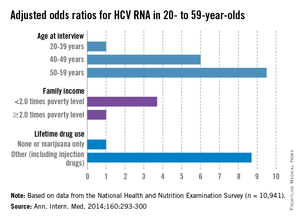
The risk factors most associated with chronic hepatitis C virus infection in Americans aged 20-59 years are age 40-59 years, illicit drug use other than marijuana, and family income less than twice the poverty level, according to investigators from the Centers for Disease Control and Prevention.
Data from 10,941 participants in the National Health and Nutrition Examination Survey (2003-2010) show that those aged 50-59 years were 9.5 times more likely and those aged 40-49 were 6.0 times more likely to have HCV infection than 20- to 39-years-olds, reported Dr. Maxine M. Denniston and her associates (Ann. Intern. Med. 2014;160:293-300).
Survey respondents who reported lifetime drug use other than marijuana (including injection drugs) were 8.7 times more likely to have chronic HCV than those with no drug use or marijuana use only, and those with a family income less than twice the poverty level were 3.7 times more likely to have HCV than were those with incomes more than twice the poverty level, the investigators reported.
Other statistically significant risk factors include male sex (odds ratio, 1.6), non-Hispanic black race/ethnicity (OR, 1.6), and high school education or less (OR, 2.0), they said.

The risk factors most associated with chronic hepatitis C virus infection in Americans aged 20-59 years are age 40-59 years, illicit drug use other than marijuana, and family income less than twice the poverty level, according to investigators from the Centers for Disease Control and Prevention.
Data from 10,941 participants in the National Health and Nutrition Examination Survey (2003-2010) show that those aged 50-59 years were 9.5 times more likely and those aged 40-49 were 6.0 times more likely to have HCV infection than 20- to 39-years-olds, reported Dr. Maxine M. Denniston and her associates (Ann. Intern. Med. 2014;160:293-300).
Survey respondents who reported lifetime drug use other than marijuana (including injection drugs) were 8.7 times more likely to have chronic HCV than those with no drug use or marijuana use only, and those with a family income less than twice the poverty level were 3.7 times more likely to have HCV than were those with incomes more than twice the poverty level, the investigators reported.
Other statistically significant risk factors include male sex (odds ratio, 1.6), non-Hispanic black race/ethnicity (OR, 1.6), and high school education or less (OR, 2.0), they said.

FROM ANNALS OF INTERNAL MEDICINE
Pseudobulbar affect common in vets with mild TBI
Symptoms of pseudobulbar affect were reported by 60% of veterans with mild traumatic brain injury in a survey of patients in the Veterans Affairs system.
Pseudobulbar affect (PBA) – a neurologic condition involving uncontrollable, disruptive outbursts of crying and/or laughing – was more common among 758 veterans with mild TBI than were posttraumatic stress disorder (48%), major depression (31%), and anxiety disorders (18%), according to Dr. Regina McGlinchey of the VA Boston Healthcare System and her associates, who reported their findings at the Tenth World Congress on Brain Injury in San Francisco.
Veterans with PBA symptoms were more likely to also have PTSD, a finding not previously reported, the investigators said. In the survey, 54% of patients with PBA also reported PTSD, compared with 32% of those who did not have PBA.
Veterans with PBA symptoms also were significantly more likely to be using antidepressants (46%) than were those without PBA (31%), and "those with PBA symptoms reported significantly worse health-related quality of life scores," Dr. McGlinchey said in a statement.
The survey was sponsored by Avanir, maker of Nuedexta (dextromethorphan hydrobromide/quinidine sulfate), which is indicated for treatment of pseudobulbar affect.
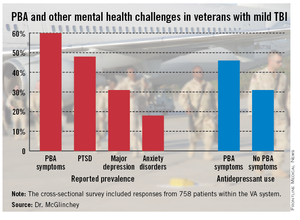
Symptoms of pseudobulbar affect were reported by 60% of veterans with mild traumatic brain injury in a survey of patients in the Veterans Affairs system.
Pseudobulbar affect (PBA) – a neurologic condition involving uncontrollable, disruptive outbursts of crying and/or laughing – was more common among 758 veterans with mild TBI than were posttraumatic stress disorder (48%), major depression (31%), and anxiety disorders (18%), according to Dr. Regina McGlinchey of the VA Boston Healthcare System and her associates, who reported their findings at the Tenth World Congress on Brain Injury in San Francisco.
Veterans with PBA symptoms were more likely to also have PTSD, a finding not previously reported, the investigators said. In the survey, 54% of patients with PBA also reported PTSD, compared with 32% of those who did not have PBA.
Veterans with PBA symptoms also were significantly more likely to be using antidepressants (46%) than were those without PBA (31%), and "those with PBA symptoms reported significantly worse health-related quality of life scores," Dr. McGlinchey said in a statement.
The survey was sponsored by Avanir, maker of Nuedexta (dextromethorphan hydrobromide/quinidine sulfate), which is indicated for treatment of pseudobulbar affect.

Symptoms of pseudobulbar affect were reported by 60% of veterans with mild traumatic brain injury in a survey of patients in the Veterans Affairs system.
Pseudobulbar affect (PBA) – a neurologic condition involving uncontrollable, disruptive outbursts of crying and/or laughing – was more common among 758 veterans with mild TBI than were posttraumatic stress disorder (48%), major depression (31%), and anxiety disorders (18%), according to Dr. Regina McGlinchey of the VA Boston Healthcare System and her associates, who reported their findings at the Tenth World Congress on Brain Injury in San Francisco.
Veterans with PBA symptoms were more likely to also have PTSD, a finding not previously reported, the investigators said. In the survey, 54% of patients with PBA also reported PTSD, compared with 32% of those who did not have PBA.
Veterans with PBA symptoms also were significantly more likely to be using antidepressants (46%) than were those without PBA (31%), and "those with PBA symptoms reported significantly worse health-related quality of life scores," Dr. McGlinchey said in a statement.
The survey was sponsored by Avanir, maker of Nuedexta (dextromethorphan hydrobromide/quinidine sulfate), which is indicated for treatment of pseudobulbar affect.

